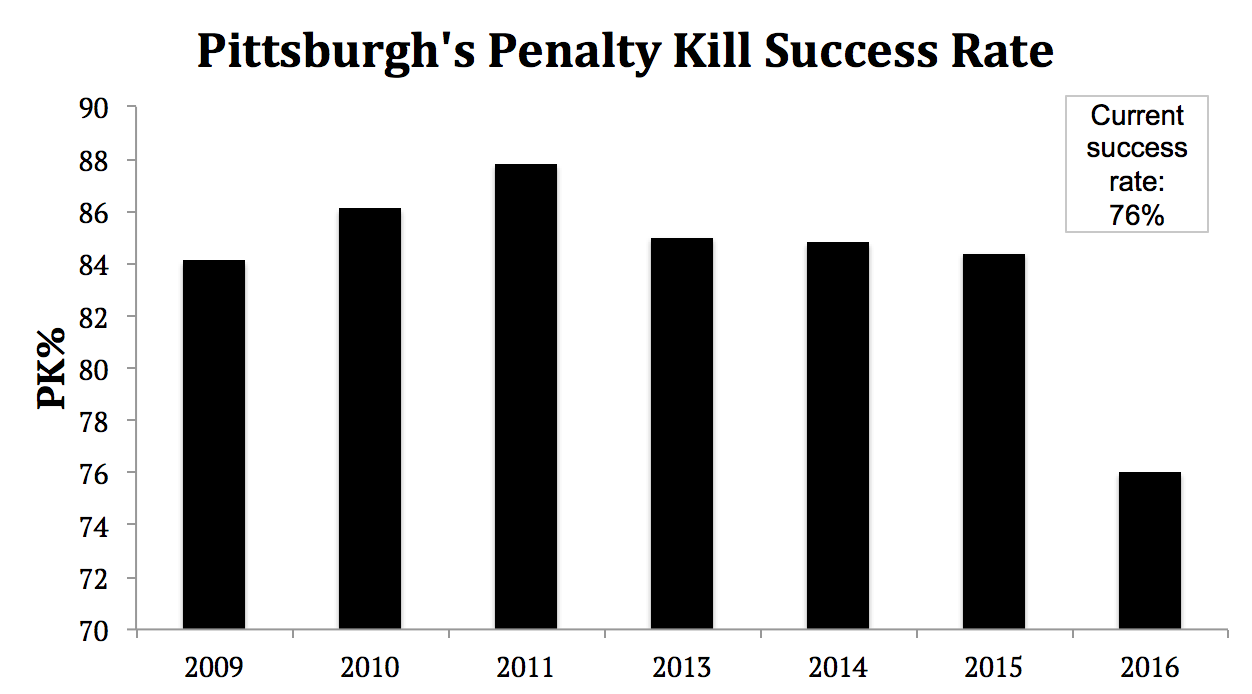The Pittsburgh Penguins’ penalty kill is so bad it’s breaking records. The team’s average penalty kill percentage is the worst it’s been in the past seven years. Excluding the shortened 2012 season, the Penguins have been in the top 10 of penalty kill units in the league since their Stanley Cup win in 2009. In 2010, they finished first in the league; they’ve never finished below ninth place in the regular season. This season, their penalty killing unit is ranked 28th,.
The Underperforming Pittsburgh PK
Pittsburgh hasn’t had a penalty kill percentage (PK%) this low in almost a decade.

The Penguins have allowed at least one goal when shorthanded in all but four of their first 27 games. They’ve allowed three power-play goals against in one game twice this season: in their game against the Wild on Nov. 25 (a game they lost) and again against Ottawa on Dec. 5 (a game they won).
Despite a nearly unchanged roster from the 2015-16 season, the Penguins penalty kill isn’t performing well. Why? As defenseman Olli Maatta said earlier this season, “Something hasn’t clicked yet.” This far into the season, the Penguins are going to have to consider if their current setup ever will.
What’s Wrong With the Penguins’ PK?
Whenever they’re shorthanded, the Penguins have a hard time clearing the puck from their own zone. Below is an example from their December 5 game against the Senators; one of the two games this season when the Penguins allowed three power play goals in one game.
In the video the Penguins’ defense only manages to clear the puck as far as the blue line before the offenders knock it back into the Penguins’ zone. It shows how the Penguins’ defense struggles to get possession of the puck, and when they do get possession, they aren’t able to clear it.
They’re giving the offending team too much time in their zone with an extra attacker on the ice, and all that time eventually leads to power play goals. The players on the ice aren’t able to establish any puck possession when shorthanded; it’s a chemistry issue that could be solved by changing the PK personnel.
So What Happens Now?
The poor performance of the penalty kill doesn’t match up to the caliber of the team itself. It is incongruent that the third-highest ranked team in the NHL has the third-lowest PK ranking. The Penguins have allowed a power play goal in 85% of their games this season. As the team nears the halfway point, that’s something that will have to change.

One option that head coach Mike Sullivan could use to switch up the penalty kill is to change his penalty killers. The Penguins’ most frequently used penalty killing unit includes Nick Bonino, Ian Cole, Carl Hagelin and Kris Letang. Hagelin is useful on the ice as a fast play disrupter and Letang is one of the Penguins’ most effective defensemen, but if something isn’t clicking between them, maybe it’s time to mix that combination up.
Eric Fehr, Trevor Daley, Matt Cullen and Olli Maatta are also regularly seen on the penalty kill. Maybe Sullivan should try mixing up these combinations by moving some of the second PK unit players up to the first. And perhaps we’ll see more appearances of Pittsburgh’s forwards, like Sidney Crosby, sometimes seen on the PK, as an experimental addition. There’s enough depth on the roster to start mixing up the combination of players. It would not be surprising if the usual PK lineup starts to shift over the next few weeks.
Something about Pittsburgh’s penalty killing unit just isn’t clicking. Twenty-seven games into the season, that’s a little worrying. We might see some changes as the team fights to climb up that PK ranking. The past six years have proven that the Penguins should be doing better on the penalty kill than they are. With some changes in the lineup, maybe Mike Sullivan can get them there.